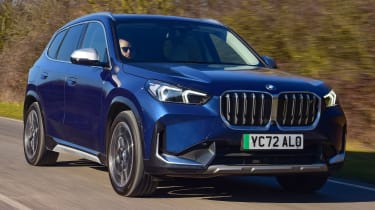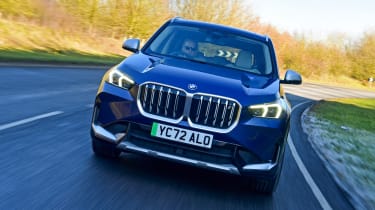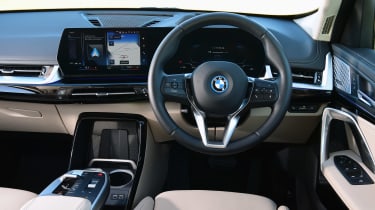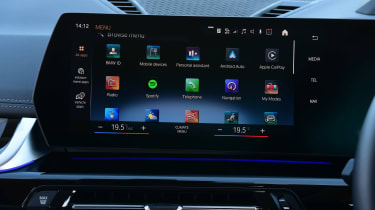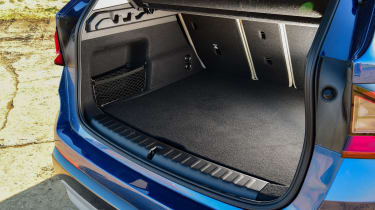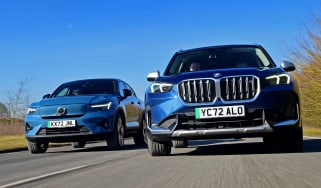BMW iX1 review
The iX1 is well built, practical and fun-to-drive pure-electric SUV, although its firm ride holds it back

PCP finance available
While not as innovative as the i3 it indirectly replaces, the BMW iX1 is a very well put-together EV with an excellent powertrain and a suitably premium-feeling cabin that helps justify its fairly hefty pricing. The compact electric SUV blends practicality with a sporting drive very nicely, but the overly firm ride and the fact it fails to crack the 300-mile mark on a single charge restricts its score somewhat.
About the BMW iX1
In 2022, production of BMW’s i3 – the pioneering electric city car – came to an end. There won’t be a direct replacement, but that means the BMW iX1 is now the German brand’s entry-level EV, partly filling the space the i3’s departure has left in a line-up that currently includes the i4 saloon, iX3 mid-size SUV, iX luxury SUV and i7 luxury limousine.
But while the i3 was a bespoke model made with a complicated part-carbon fibre, part-aluminium structure, the iX1 is merely an electric version of the latest X1 SUV, built on the same platform as multiple other BMWs and the next-generation MINI Countryman. While the i3 looked rather quirky, was complicated to produce and was a bit too ‘out there’ for some potential buyers, the iX1 is thoroughly normal. If you ignore the giant kidney grilles, that is. Criticise the iX1’s more conventional nature if you really want, but we expect it’ll lead to more popularity in the showroom.
The list of rivals for the iX1 is a veritable who’s who of the premium family EV segment, with the most direct competitors being the recently updated Volvo XC40 Recharge, its coupe-esque C40 Recharge sister car, the Audi Q4 e-tron and Mercedes EQA. High-spec versions of the Hyundai Ioniq 5, Kia EV6, Nissan Ariya and Tesla Model Y fall into the same price range as the iX1. They all offer more range and most of them have more boot space too, although they’re more openly EVs than the iX1.
More reviews
Car group tests
In-depth reviews
Long-term tests
Road tests
The BMW iX1 currently starts from over £53,000 – nearly £20,000 more than the base X1; buyers are given a choice of the familiar xLine and M Sport specifications, with plenty of optional extras available. Standard kit includes LED headlights, 18-inch alloy wheels, an automatic tailgate, two-zone climate control, a reversing camera, adaptive cruise control, interior ambient lighting, 10.25-inch digital driver’s display and 10.7-inch central touchscreen running the latest iteration of BMW’s iDrive infotainment system, iDrive 8, plus Apple CarPlay and Android Auto.
Motors, performance and drive
Although we tested the entry-level xLine version of the iX1 rather than the M Sport with its more focused suspension set-up, we still found it too firm. The car is a tad jittery on some surfaces at higher speeds, while speed bumps and larger potholes can be felt in the cabin quite obviously. As it stands, the body stays plenty flat during hard cornering, so BMW could afford to soften the damping a touch.
We have no doubt that some will like the look of the larger rims BMW offers, but we’d definitely recommend the smallest wheels for the iX1, becausethey help to take the edge off a firm ride. Otherwise, motorway refinement is excellent, and you feel well isolated from road and wind noise, plus the car feels very stable at high speeds.
The steering doesn’t offer much in the way of feedback, and as we find in many current BMW products, it’s quite a weighty set-up. It’s predictable enough, though, and set at the right sort of speed. It’s also possible to do a little bit of steering from the other end of the iX1, as a greedy mid-corner throttle application can lead to some limited movement from the rear axle.
The BMW is a fun, engaging car to drive quickly, helped by a chassis that does a good job of shrugging off the iX1’s considerable weight figure. During more relaxed driving, we encountered a little more wind and road noise than we might have liked, but nothing too excessive. In any case, you can always drown this out with the excellent Harman Kardon sound system – a worthwhile upgrade in our opinion, even at £660.
What doesn’t work so well is the calibration of the brake pedal, which makes it very hard to smoothly pull to a stop. The first part of the pedal travel doesn’t do a whole lot, but press it a little more firmly, and the brakes bite aggressively. One way around this is to use the strongest of the five regenerative brake settings, which allows for one-pedal driving and is easily accessed via the ‘B’ mode on the gear selector. The rest can be chosen through the touchscreen, which is more fiddly than having steering wheel-mounted paddles like a Hyundai Ioniq 5.
0-62mph acceleration and top speed
At launch the iX1 is only offered with the ‘xDrive30’ powertrain that uses two electric motors for all-wheel drive, as well as producing 313bhp and 494Nm of torque. That’s a lot of oomph for a compact SUV, but remember the iX1 weighs over two tonnes. The 0-62mph sprint takes 5.7 seconds and at full throttle we found the iX1 feels brisk rather than properly fast – once you’re over the shock of the instant delivery of that near-500Nm torque output.
If you’d like, acceleration can be accompanied by a sci-fi-esque feedback noise provided by film composer Hans Zimmer, which works surprisingly well. Behind the steering wheel is a single, left-hand paddle, which engages the ‘boost’ mode, allowing the two electric motors to deliver their full potential for 10 seconds.
Range, charging and running costs
During our time with the iX1, we averaged 3.1 miles per kilowatt-hour, which doesn’t sound too impressive, but a good chunk of the test was done in battery-unfriendly sub-zero temperatures. Plus, when we tested the iX1 against a Volvo C40 Recharge, the Swede could only muster 2.9mi/kWh. In warmer conditions, we’d expect that number to rise considerably, but as it stands a full battery displayed a predicted range of 201 miles – a long way off the iX1’s 270-mile official range.
The iX1 can be topped up at a rate of 130kW, which is lower than some rivals like the Volvo C40 Recharge, but one of the key elements of BMW’s latest EV tech comes in its software. Charging rates tend to tail off as they reach peak capacity, but just like with the latest i7 limousine, the iX1’s programming means that the rate tails off less abruptly than in previous BMWs.
As a result, if you plug into a suitable ultra-rapid DC charging point, you can fill up the 64.7kWh battery pack from 10 to 80 per cent in a very reasonable 29 minutes. For home charging, a standard 7.4kW wallbox will take about ten and a half hours to fully recharge the iX1’s battery.
Starting from over £53,000, the iX1 is certainly expensive for an electric SUV of this size, but it benefits from the same perks as all electric cars. That includes an exemption for road tax (VED) and the London Congestion Charge until 2025, plus company car drivers are sure to enjoy the 2 per cent Benefit-in-Kind tax rate the iX1 attracts for the next few years.
Insurance groups
The BMW iX1 falls into insurance group 37 (out of 50) if you go for the base xLine model, while M Sport models land in group 38. As a result, it should cost around the same money to insure an iX1 as it would a dual-motor version of the Audi Q4 e-tron or Volvo XC40 Recharge.
You can get personalised car insurance quotes fast with our comparison tool powered by Quotezone...
Depreciation
According to our expert data, the BMW iX1 will retain roughly 58 per cent of its original value after three years of ownership and 36,000 miles.
To get an accurate valuation on a specific model check out our valuation tool...
Interior, design and technology
There aren’t too many visual giveaways that you can use to differentiate the iX1 from any other X1, especially if you go for the M Sport trim, which does without the lightning blue exterior trim that’s become a signature of BMW’s electric cars. The only obvious sign that this is an EV is the lack of any exhaust pipes and the blanked-off grille, although we expect buyers not wishing to shout about their switch to electric will find this appealing.
The cabin is a premium-feeling space with excellent material quality and a general feeling of sturdiness that does plenty to justify the iX1’s £53k starting price. The dashboard is topped with a curved panel incorporating a pair of displays – one for the instrument cluster, and the other for your infotainment and climate controls. The floating centre console contains drive and infotainment shortcuts, allowing for that minimalist dashboard design.
Continuing a theme we’ve seen on other newer, smaller BMW models, there’s no rotary iDrive controller, which seems like a shame. The device has long been a trademark of BMW’s infotainment set-up and is really easy to use on the move. Throughout our time with the car, muscle memory found us reaching for the non-existent dial, leading to a little pang of disappointment each time.
We will say that BMW’s newer steering wheel design looks surprisingly simple and minimalist compared with earlier efforts. But look closely, and you’ll see all the key buttons are there and they’re all physical, not just touch-sensitive panels.
Sat-nav, stereo and infotainment
The 10.7-inch touchscreen sits in the middle of the dash, and adapts the previously slick iDrive set-up onto a sharper, more responsive screen. The main menu page for the iDrive 8 operating system features large, logical tile shortcuts, which make the iX1’s system easy to navigate. It’s a shame that the clickwheel has been ditched because it was very useful for making minor adjustments on the move, but some physical shortcut buttons are still present.
While much of the climate-control system has migrated to the touchscreen, permanent on-screen keys make it easy to adjust while driving. Enter the climate menu and the button sizes are large enough to hit even while using peripheral vision, meaning you don’t really need to take your eyes fully off the road.
Practicality, comfort and boot space
Step inside and the iX1 greets you with a light, airy cabin that really helps to give the feeling that BMW has maximised the space available. The open cabin design means that there isn’t much space for hidden storage beyond the glovebox, but the iX1 still has plenty of useful touches. For example, the wireless charging pad between the front seats is nearly vertical, but a plastic clip stops your phone sliding around while you’re driving.
There’s also a pair of deep cup-holders and a large shelf just beneath the floating console. What is slightly odd is the lidded cubby in the centre console, which is hinged towards the passenger in the UK because it’s been designed for left-hand-drive markets.
Isofix points are fitted on the BMW’s back seats and are easily accessible behind small hinged covers, plus there’s a third mounting on the front passenger seat, should you need it.
Size
Despite its chunky square-jawed proportions, the iX1 is a modestly sized SUV, which helps prevent it from being intimidating to drive in town. At 4,500mm long, the iX1 is actually slightly shorter than a BMW 2 Series Coupe and it’s almost exactly the same width. But standing 1,642mm tall gives it the commanding stance and driving position SUV buyers look for.
Leg room, head room and passenger space
Because its battery pack is stored beneath the floor of the car, cabin space in the iX1 is identical to the petrol or diesel-powered X1, so there’s a decent amount of room for adults to stretch out. Headroom in particular is impressive, and the rear bench’s backrests also recline, which lets occupants relax more easily on a long trip. Our biggest frustration is that the centre console stretches quite far back, taking up valuable foot space for middle-seat occupants.
Boot
The iX1 has 490 litres of boot space, which is down on the 540 litres you get in a regular X1, but the decrease is all in the underfloor storage area, so most of the time you won’t notice. In any case, what remains of the underfloor compartment can still squeeze in a charging cable. Plus, the BMW’s capacity still trumps the 340 litres in the Mercedes EQA, or the 402 litres you get in a Ford Mustang Mach-E.
Folding the 40:20:40-split rear seats down in the iX1 expands the luggage capacity to 1,495 litres – over 150 litres more than you get in the EQA or an electric Volvo XC40 – though the seats don’t drop far enough to form a flat load space.
Reliability and Safety
The regular X1 range was assessed by Euro NCAP in 2022, coming out the other end of the organisation’s crash test with the maximum five-star rating. It scored 86 and 89 per cent in the adult and child occupant occupant categories respectively, and received an impressive 92 per cent for safety assistance technology. Unfortunately, the combustion-engine X1’s score doesn’t apply to the fully electric iX1, although we expect it’ll perform just as well, if not better, when it’s put to test.
That’s because every iX1 is equipped with a reversing camera, an ‘attentiveness assistant’ that can suggest if you need to take a break, and BMW’s ‘active guard’ system, which incorporates lane-departure warning and front collision warning with brake intervention. Like many EVs, the iX1 produces a distinctive sound at low speeds to make pedestrians aware of its presence.
You can also get adaptive cruise control, cross-traffic warning, lane-change warning, rear collision prevention, and steering and lane control assistant if you get the optional ‘Driving Assistant Professional’ pack.
We won’t know how reliable the iX1 is until owners have had a chance to put some serious miles on their cars. But considering the i3 was on sale for nearly a decade without any major issues to speak of, and BMW’s fifth-generation electric-car technology can also be found in the i4, iX3, iX and i7, it all suggests to us that the compact electric SUV will be pretty reliable.
In the most recent Driver Power owner satisfaction survey, BMW as a brand came 19th out of 29 best manufacturers, ahead of key competitors Audi (22nd) and Mercedes (23rd).
Warranty
All BMWs come with a three-year/unlimited-mileage warranty, but the iX1 gets some extra coverage from the ‘i’ electric-car warranty that includes BMW Mobile Care and protection for the vehicle’s high-voltage battery for up to eight years or 100,000 miles, whichever comes first.
Servicing
Although the iX1’s service schedule hasn’t been confirmed, we don't expect it’ll need to be looked at more than once every other year – the same as the BMW iX3 SUV and i4 saloon. To make maintenance easier, BMW offers an inclusive service package for the iX1 that covers routine servicing for at least the first four years after your vehicle’s registration date. It’s priced at £410, but BMW also has a pay-monthly service plan if you need to spread the costs.
For an alternative review of the BMW iX1, visit our sister site drivingelectric.com...

